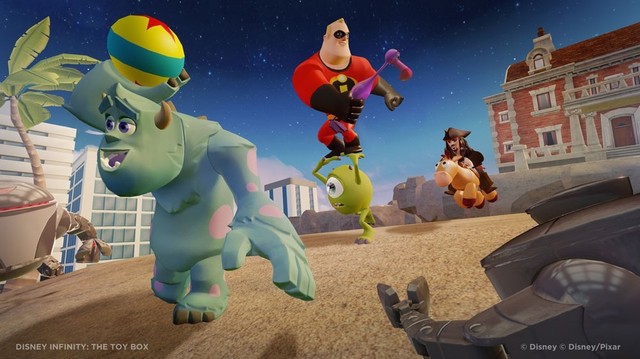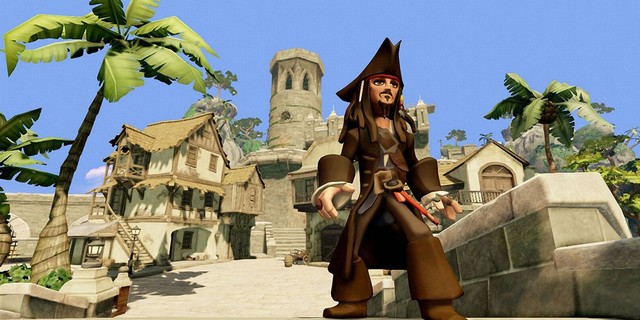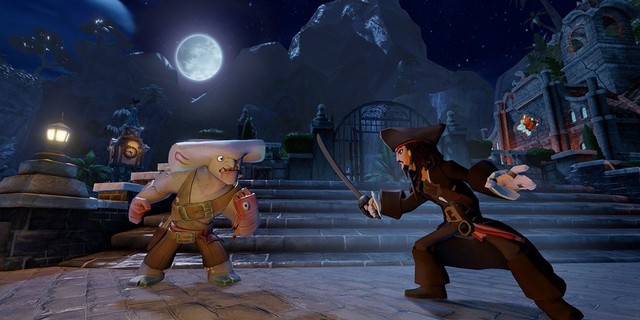Two years ago, I was assigned the incredible opportunity to review Toys For Bob and Activision’s Skylanders debut on the Nintendo Wii. At the time, the Spyro franchise was in a bit of a death spiral and Skylanders blew me away with its fantastic gameplay. But what was most impressive, and most concerning frankly, was the Skylanders’ tie in to the physical world with groundbreaking technology consisting of a round game base, the Portal of Power, and a series of collectible figurines that when purchased and placed on the base, would magically (or to be more accurate, through the magic of near field communication) appear on-screen for play in the game.
Even more incredible was the fact that each figurine contained a unique internal memory with up-to-date in-game character stats, affording gamers the ability to take their personal leveled-up characters to a friend’s home and immediately jump into any game – regardless of the gaming platform (PC, 360, PS3 or Wii).
I say most concerning, because at the time the thought of gamers ponying up $7.99 each for additional game characters, after having just spent nearly $80 on the initial Skylanders Starter Pack seemed absolutely absurd. Boy, was I wrong – because Skylanders immediately became the must-have game of the 2011 holiday season, and the figurines became instant collectors’ items – complete with the formation of their own online auction and trading culture.
A year later, the folks at Skylanders’ developer Toys For Bob upped the ante with the addition of Skylanders Giants – reusing the same portal of power and allowing gamers to simply incorporate the larger characters into the new storyline. The idea was successful, as Giants quickly made it to the top of the 2012 holiday lists.

Never a company to miss out on an opportunity to cash-in on a trending fad, Disney has suddenly stepped into the figurine-based video game arena with their own Skylanders-esque epic, called Disney Infinity. Infinity takes the Skylanders near field communication portal concept, and into that incorporates Disney’s rich stable of film characters ranging from (at the time of this writing) Monsters Inc., The Incredibles, Pirates of the Caribbean, and Cars. While this may seem like the formula for the ultimate gaming experience, Infinity proves to be a unique dichotomy of gaming sensibilities, and the result is an experience that is every bit as astonishing as it is disappointing, and as enjoyable as it is frustrating.
So, Infinity is basically Skylanders in the Disney universe, right? Well, no. It is definitely not. In fact, other than the fact that there is a USB portal that performs near field communication with memory chips buried within figurines transferring characters into the game (I suppose that is a significant similarity, but read on), the games are actually quite different. Infinity is actually not one game, but multiple games – the starter pack delivers what is technically four separate gaming experiences, with the promise of more in the future (Infinitely more, in fact) at an added cost, of course.
Yes, we need to get something out in the open right from the start – Infinity, certainly more than Skylanders, is cleverly designed to maximize Disney’s cash flow at an alarming rate. Let’s put this in perspective. The starter pack retails for $75-$80 depending on where you get it. This pack includes three character figurines: Sully, Mr. Incredible, and Jack Sparrow. The pack also includes a translucent cube that contains the “Play Sets” for each of the included characters – Each Play Set consisting of the worlds and missions for the single-player games of Monsters University, The Incredibles, and Pirates of the Caribbean.
I emphasize “single player” because in reality, much like Skylanders, Infinity allows gamers to play each Play Set cooperatively with a friend (what we reviewers like to call co-op play) – but here is the catch – only if the second player has a character from the world being played. What does that mean? It means that a second gamer cannot use the Mr. Incredible character to help out a friend playing the Monsters University Play Set with Sully – Pixar or not, gaming worlds cannot be crossed in the Play Set mode. It would require the purchase of another Monsters Inc. character – like Mike Wazowski or Randall.

Each additional character runs around $13-$15 – considering that it would take three additional characters to play co-op in all three games, you now have to add $45 to the additional purchase price. Disney tries to go nice on gamers by offering $30 3-packs, with names like “Sidekick Pack” (Mike Wazowski, Mrs. Incredible, and Barbossa) and “Villain Pack” (Randall, Syndrome, and Davy Jones) – but even that pushes the total cost over $100.
I mentioned earlier that Cars was included in the Infinity stable – well it is, but not in the Starter Pack. You will have to shell out a little extra for that, too – as in $40 extra. For that $40, however, you will receive two cars figurines (Lightning McQueen and Holley) and a translucent trophy which is used to unlock the Cars game world and missions within Infinity. For $40, to get two figurines and what equates to an entirely new gaming experience is not that bad a deal in the big picture. But with figurines and Play Sets either already on the shelves, or soon on the way, for properties like Wreck It Ralph, The Lone Ranger (shouldn’t they be paying us for that?), and Disney classics like Fantasia – the total cost of ownership is already pushing $300 and climbing. And that’s not including all of the $5 blind-buy collectible power-up packs at store counter.
Of course, gamers do not have to buy all of the figurines, and Play Sets, and trinkets to have fun with Infinity – but Disney seems to have a unique hook for eeking a few more dollars out of gamers’ pockets every chance they can with Infinity, and they make it really enticing.

That said, the remainder of this review will be centered on only what experience can be had with the Starter Pack; the single player missions of Monsters University, The Incredibles, and Pirates of the Caribbean, as well as the user-generation Toy Box mode – all using the three included characters.
The Monsters University Play Set put gamers in the shoes, er…fur, of blue behemoth Sully as he torments the folks at Monsters University’s rival school, Fear Tech. Sully does his best Sam Fisher impersonation as he traverses around the school scaring students and staff, defacing school structures, and sabotaging school events. The best game I could compare it to would be a toned-down version of Rockstar’s Bully. Being the prankster is great fun, but it can also be a bit lonely at times – especially when the cutscenes make it brutally obvious that the game was designed with co-op in mind when Mike Wazowski stars in nearly every one yet is conspicuously missing in the gameplay.
Whereas the Monsters University Play Set was like Rockstar’s Bully, the Incredibles Play Set is more akin to Rockstar’s Grand Theft Auto – although without any of the nasty business. In Metroville there are no hookers or drug lords, but it does have the similar open-world mission-based gameplay in which Mr. Incredible receives various assignments from Edna to find certain people or objects.

All the while, Metroville is overrun with robotic minions who appear constantly around each corner, requiring Mr. Incredible to take action to protect the South Park-esqe citizens. While these robots are hardly that difficult to destroy, the constant button mashing required to stop their never-ending attack hearkened back to the likes of Dynasty Warriors more than I really cared to experience.
The Pirates of the Caribbean game is an all-out hack-n-slash game that one would expect from sword-toting pirates. Easily my favorite of the bunch, the developers have done a fantastic job capturing Jack Sparrow’s stumbling, bumbling essence, and delivering pirate adventure worthy of the license. True, it also had a certain Dynasty Warriors feel to it, but what do you expect – that’s what pirates do best!
When gamers are tired of playing the single player missions, they are free to take their characters and any earned items into the user generation Toybox mode. Toybox does a really good job of taking what gamers love about user creation games like Minecraft and LittleBigPlanet, and places it within the Disney universe. This is also the only game mode in which Infinity allows for the cross-mixing of character world – Jack Sparrow can battle against Mr. Incredible if you so wish.

Most of Toybox’s fun is derived from building objects, gaming modes, and devices using items gained in the single-player campaign. And while Infinity offers nowhere near the complexity, nor the library of user-created content, of LittleBigPlanet – it does deliver a surprising amount of variety. Given that this is the only place that two players with a Starter Pack can play together; this is also the place where most party play is going to take place.
Within mere minutes of installing the game, my children (12yrs and 8yrs old) were already setting up their own player vs. player arena shooting matches, complete with computer-controlled bots to round out the fun. They enjoyed using the gadgets and items they had collected in the single player campaign in building their own play worlds, and they liked the ability to download and incorporate additional content and playsets from the Infinity online portal. It still is not clear if Infinity’s servers will support user generated content to the degree of LittleBigPlanet – like letting gamers trade their Toybox world designs – but Disney’s Infinity web site hints at that being a very real possibility once the PC and iOS versions are released.
Infinity’s presentation is surprisingly lackluster for what I would expect from a Disney license. The three main worlds all have the basic visual architecture of their respective films, but each seems a bit sparse and under -populated in terms of both inhabitants and structures. Whereas the Metroville of the film was a hustling-bustling urban metropolis of 50’s era futurism, the Metroville of the game seems more like a laid-back bayside beach town with only a handful on the road at any given time and it’s Beanz-shaped bystanders.
Coupled with the fact that each and every world suffers from periods of severe lag, and drops frame rate it is all a bit disappointing. There were times that the onscreen action actually reached an extended period of stoppage, resulting in brief moments of “did the game just crash on me?” worry, just prior to kicking back into action. This was tested on two PS3’s of differing age and model, and both reacted similarly.

The audio is surprisingly second-rate for a Disney entity, as well. While I hardly expected the developers to pony up for the likes of John Goodman, or Johnny Depp to voice their well-known characters, it would have been nice if the voice actors they did get sounded at least a little like the original actors.
Star power or not, it would not have been hurt if the actors actually sounded like they gave a damn about the lines they were delivering. For instance, while the developers were actually able to snag Craig T. Nelson (according to iMDB) to reprise his Mr. Incredible film counterpart, he hardly sounds incredible delivering the lines – in fact he sounds like he is barely able to stay awake. I guess I can understand an aging actor to feel a bit put out with a role as a video game voice, but you would think that a jobber filling in for a great like Johnny Depp would give his heart and soul for this opportunity. Instead, we get dry, monotone, and completely uninterested delivery.
Presentation and repetitive gameplay problems aside – I still really enjoyed my time with Infinity. And as for my kids – they absolutely loved every minute of it, and still are. We have already sunk an additional $40 in extra characters and powers as of this writing, and we are saving up to get the Cars (available now) and the rumored Wreck It Ralph play sets – so I guess Disney has succeeded in getting their hooks in us just as they intended.
























